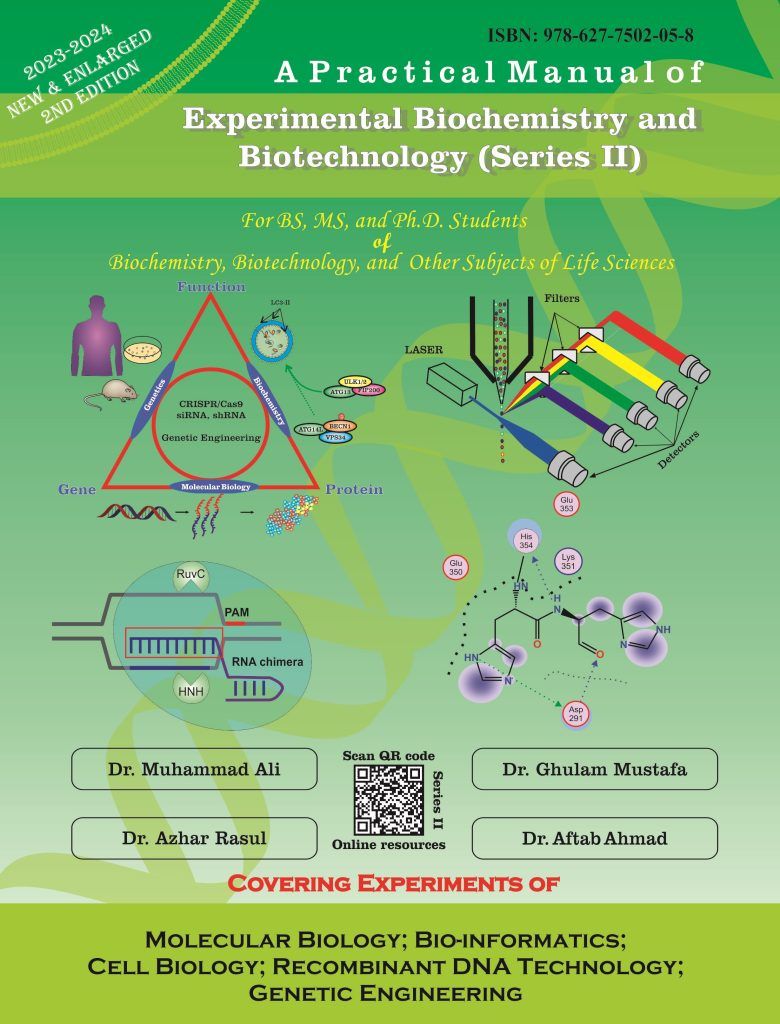
Ordering Information
Price: 400/- PKR
Edition: 2023-2024 (2nd edition)
ISBN: 978-627-7502-05-8 (Print)
Published by Dr. Muhammad Ali
Ninety-five (95) full-length experiments are included
© Copyright 2023. All rights reserved by Dr. Muhammad Ali
Contact us for purchase and online ordering:
0320-7177763
[email protected]
Video lectures of almost all the experiments will be uploaded sequentially.
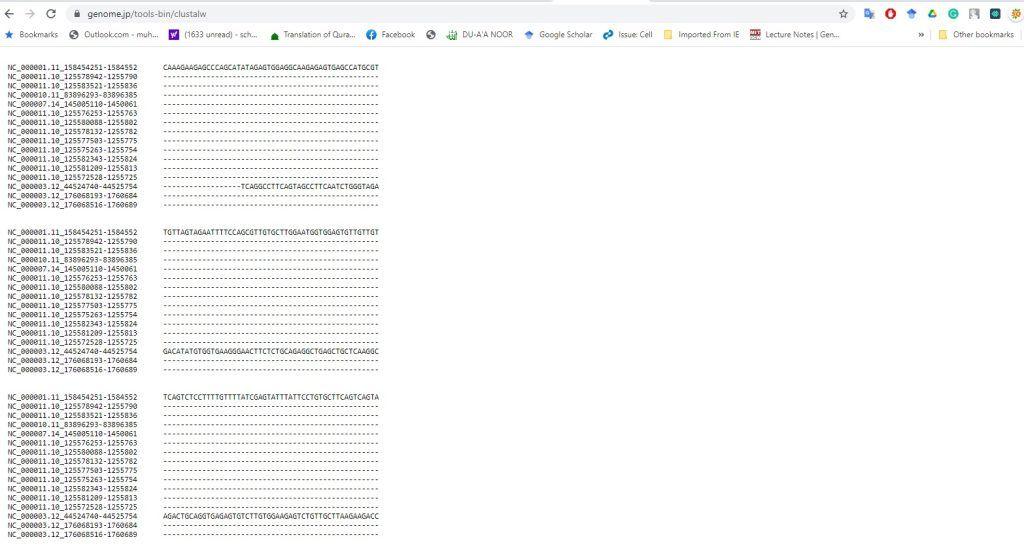
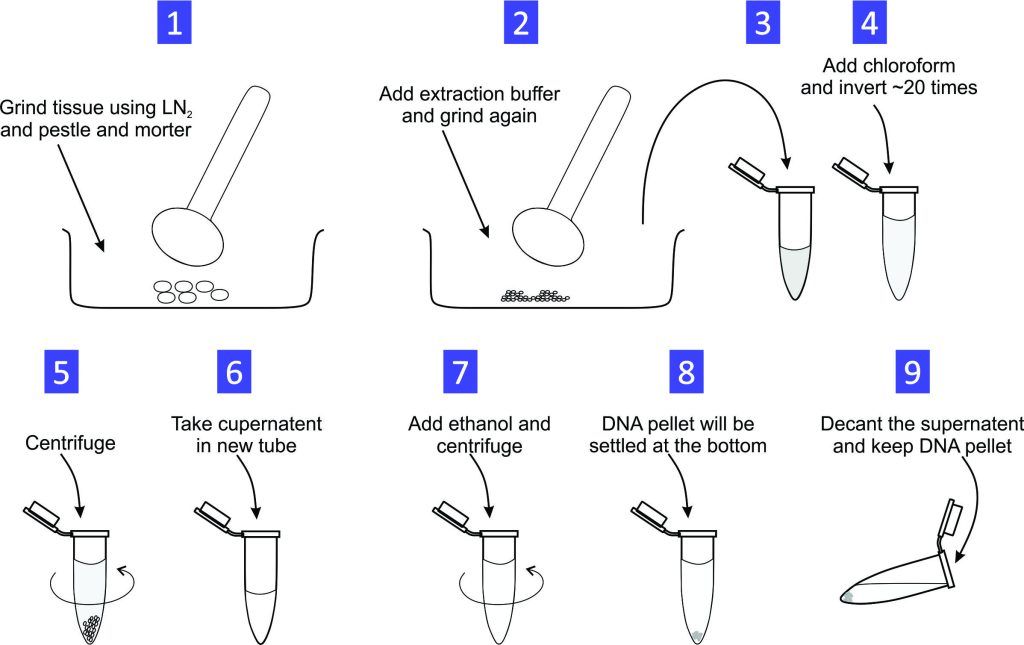

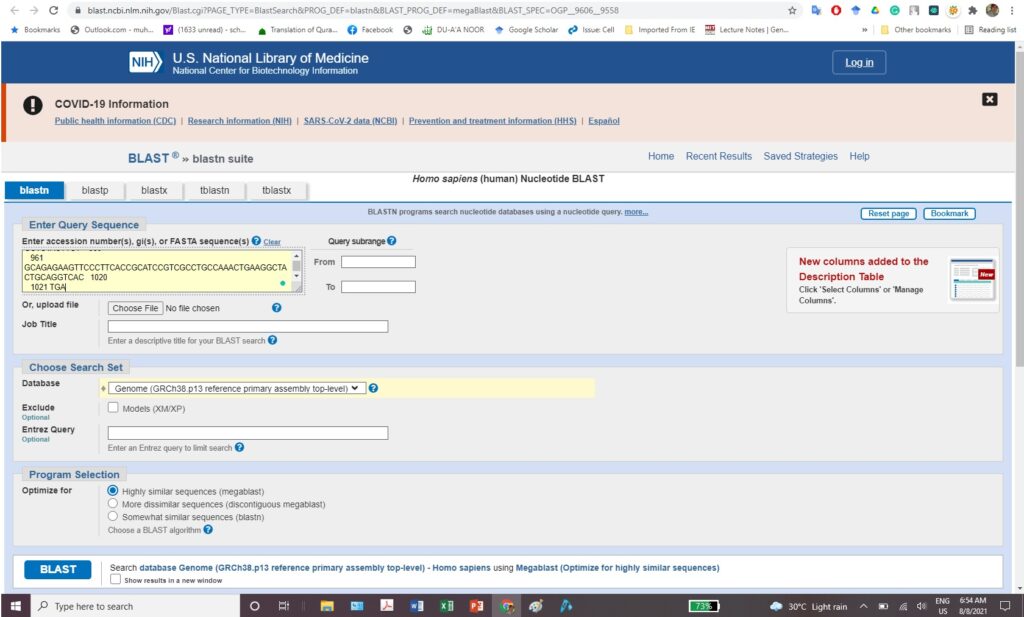
Contents of EBB Series-II (Green)
Experiment 1.1- Total Genomic DNA extraction from plant by the CTAB method. 5
Experiment 1.2- DNA extraction from fungi 6
Experiment 1.3- Miniprep extraction of plasmid from bacteria. 6
Experiment 1.4- Total genomic DNA extraction from mouse tail/tissue. 7
Experiment 1.5- Quick tail DNA extraction (Jackson’s lab) 8
Experiment 1.6- DNA extraction from blood. 8
Experiment 1.7- Quantification of DNA and RNA by nanodrop. 9
Experiment 1.8- Designing of primers for endpoint PCR from coding sequence of EI24. 10
Experiment 1.9- Designing of primers for qPCR to check transcription of EI24. 15
Experiment 1.9- Polymerase chain reaction (PCR) for genotyping. 20
Experiment 1.10- Agarose gel electrophoresis of PCR product ~150 bp long. 21
Experiment 1.11- Restricting fragment length polymorphism (RFLP) 22
Experiment 1.12- Quality test of RNA by agarose gel electrophoresis. 22
Experiment 1.13- Polyacrylamide gel electrophoresis (PAGE) of PCR product. 22
Experiment 1.14- Gel extraction protocol (Qiagen Gel Extraction Kit) 24
Experiment 1.15- Purification of PCR product and enzyme-mediated digestion. 24
Experiment 1.16- RNA extraction from cultured cells/tissue. 25
Experiment 1.17- Reverse transcriptase polymerase chain (RT-PCR) reaction. 25
Experiment 1.18- Quantitative PCR (qPCR) and operation of the software. 26
Experiment 1.19- Tissue sample lysis for Western blot analysis. 28
Experiment 1.20- Lysis of cultured cells for Western blot analysis. 28
Experiment 1.21- Ammonium sulfate-facilitated protein concentration. 29
Experiment 1.23- Protein quantification by BCA method and protein normalization. 30
Experiment 1.24- SDS-PAGE gel for protein samples. 31
Experiment 1.25- Continuous gradient SDS-PAGE for protein samples. 32
Experiment 1.26- Coomassie Brilliant Blue (CBB) staining for SDS-PAGE. 33
Experiment 1.27- Silver staining for SDS-PAGE gel 33
Experiment 1.28- Western blotting of protein samples obtained from cells and tissues. 34
Experiment 1.29- Protein immunoprecipitation to find protein-protein interaction. 36
Experiment 2.1- Use NCBI to retrieve sequence of PGC1 alfa gene, mRNA, and protein. 39
Experiment 2.2- Use NCBI to retrieve coding and protein sequence of EI24 gene. 42
Experiment 2.3- Translate DNA sequence into RNA sequence. 42
Experiment 2.4- Aligning nucleotide and amino acid sequence of EI24 from human and mouse. 42
Experiment 2.5- How you will draw dandogram among different species taking sequence of TERT. 42
Experiment 2.6- Drawing dandogram by using data obtained from RAPD primers. 43
Experiment 2.7- How will you retrieve data and draw phylogenetic tree. 43
Experiment 2.9- Determining of the hydrophobicity or hydrophilicity of protein. 45
Experiment 2.10- Prediction of trans-membrane helix. 46
Experiment 2.11- Secondary structure prediction. 46
Experiment 2.12- Structure Prediction. 46
Experiment 2.13- Codon optimization. 46
Experiment 2.14- Designing gene specific primers using primer blast, primer 3, and primer quest 47
Experiment 2.15- How you will design qPCR primers (SYBR green and probe based) for EI24 gene. 47
Experiment 2.16- Authentication of primers using online tools (oligo analyzer and ). 47
Experiment 2.17- Finding structure (secondary and tertiary) of EI24 proteins using online tools. 48
Experiment 2.18- How you will evaluate 3D structure of EI24 protein. 48
Experiment 2.19- How you will perform gene set enrichment analysis. 48
Experiment 2.20- How will you find signature genes for autophagy and breast cancer. 48
Experiment 2.21- Finding correlation of EI24 with signature genes of autophagy and breast cancer. 49
Experiment 2.23- Prediction of Drug-Receptor interaction Using MOE. 49
Experiment 3.1- Study of cheek cells using methylene blue staining. 54
Experiment 3.2- Study of onion cells and using iodine staining. 54
Experiment 3.3- Observation of fungi cells by lactophenol cotton blue staining. 55
Experiment 3.4- Differentiation between gram +ve and gram –ve bacteria. 55
Experiment 3.5- Stamen hair cells of Tradescantia (light microscopy) 57
Experiment 3.6- Studying different stages of mitosis in onion root tip cells. 57
Experiment 3.7- Study of different stages of meiosis in Tradescantia ohiensis. 58
Experiment 3.8- Different stages of meiosis in the testes of grasshopper. 58
Experiment 3.9- Observing chromosome obtained from blood cells. 59
Experiment 3.10- Observing chromosome obtained from adherent cells (HeLa) 59
Experiment 3.11- Immunohistochemistry (IHC) using anti BrdU antibody. 60
Experiment 3.12- Histology cell shape of skeletal, cardiac, and smooth muscles. 62
Experiment 3.13- White adipose tissue. 63
Experiment 3.14- Liver anatomy and histology. 63
Experiment 3.15- Difference of seed and stem of monocots and dicots. 64
Experiment 3.16- Subculturing adherent mammalian cells. 65
Experiment 3.17- Reviving mammalian cell lines. 66
Experiment 3.18- Cell counting for mammalian cell lines. 66
Experiment 3.19- Cell freezing protocol from ATCC. 67
Experiment 3.20- Thawing of suspension cells. 68
Experiment 3.21- Transfection using lipofectamine. 68
Experiment 3.22- Co-transfection of plasmid DNA and siRNA.. 69
Experiment 3.23- Electroporation of U2OS cell line. 69
Experiment 3.24- Lentivirus production to knockdown TERT mRNA.. 70
Experiment 3.25- Lentivirus Infection and knockdown of TERT mRNA.. 71
Experiment 3.26- Stable cell line expressing EI24 (Transfection method) 72
Experiment 3.27- Preparation of Mouse Embryonic Fibroblasts (MEFs) 73
Experiment 3.28- Luciferase reporter assay. 74
Experiment 3.29- Immunocytochemistry (ICC) for the detection of two proteins. 74
Experiment 3.30- Fluorescently Activated Cell Sorting (FACS) analysis. 75
Experiment 3.31- Determination of cell cycle by FACS. 77
Experiment 3.32- MTT assay for cell viability. 78
Experiment 3.33- Colonogenic assay (crystal violet assay) 78
Experiment 4.1- Preparation of competent cell 81
Experiment 4.2- Transformation of plasmid containing mutated sequence of TRAF6. 82
Experiment 4.3- TA cloning and selection by blue & white colonies. 83
Experiment 4.4- PCR-facilitated introduction of restriction sites and digestion. 84
Experiment 4.5- Restriction of MMTV- ERT2CreERT2 and gel elution. 85
Experiment 4.6- Ligation of the insert into the vector. 86
Experiment 4.7- PCR-facilitated deletion of RING domain from human TRAF6. 87
Experiment 4.8- PCR-facilitated generation of the point mutation (Pro to Leu) 88
Experiment 4.9- PCR-facilitated addition of HA tag at N-term of TRAF6. 90
Experiment 4.10- Production of recombinant insulin. 92
Experiment 4.11- CRISPR/Cas9 for the generation of Tert knockout cell lines and mice. 94
Experiment 4.12- CRISPR/Cas9 to generate Tert knock-in mice at Rosa26 locus. 96
Experiment 4.13- Analyzing mutations generated in Tert knockout cell line/ mice. 98
4.2 Useful numbers for cell culture. 100
4.3 Some restriction enzymes. 101
4.4 Reagents for Biochemistry and Biotechnology lab. 102
4.5- Composition for Tris-glycine SDS-Polyacrylamide Gel Electrophoresis (SDS-PAGE) 103
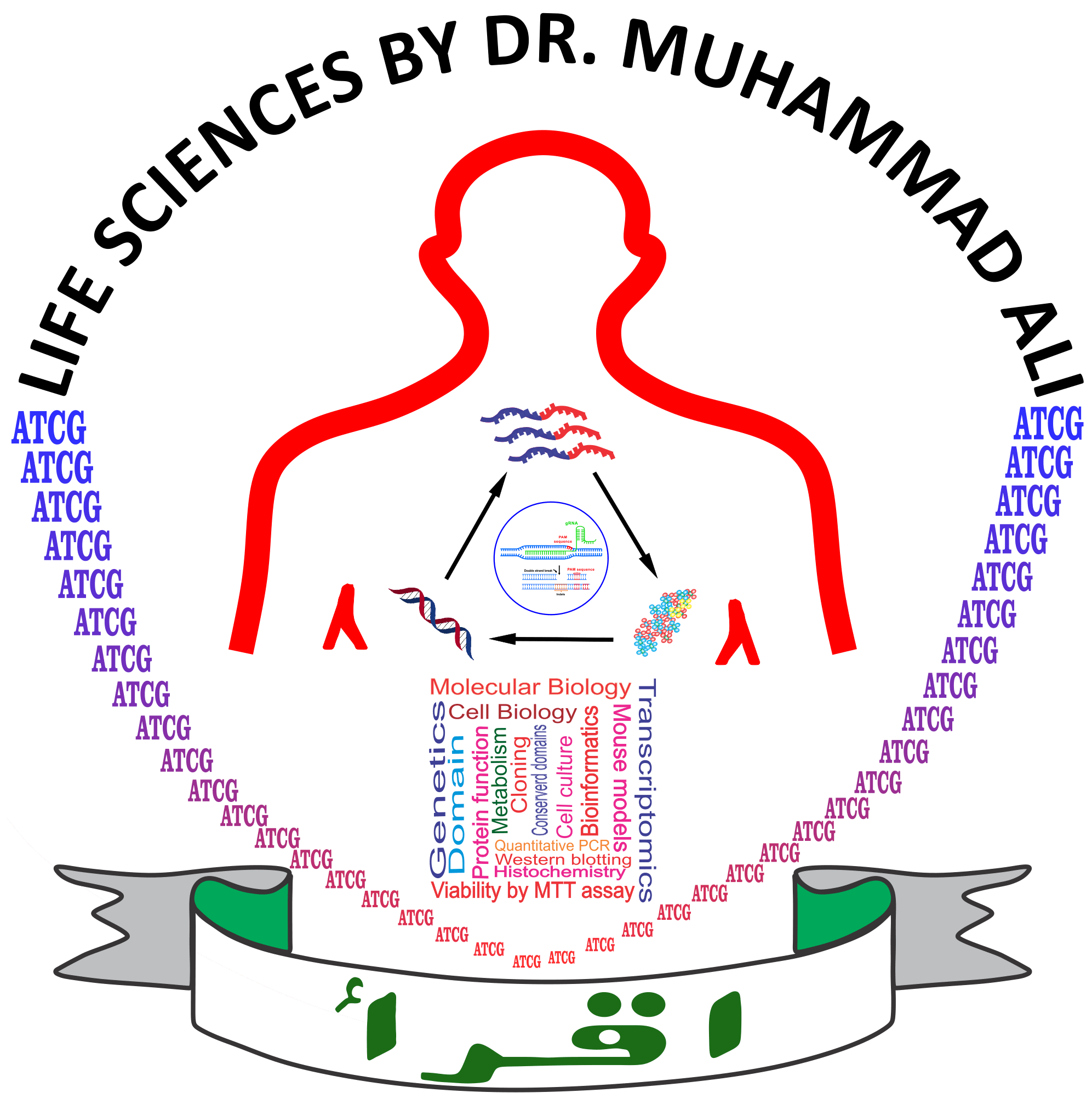
Comments are closed.